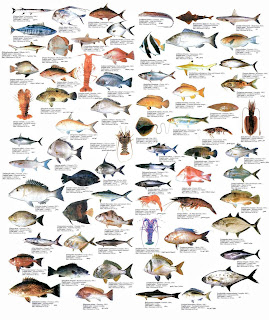Hadhramout: list of fish found in its Sea Water
Hadhramaut is rich in fish. All in the Arabian Sea which extends along Hadhramout's long coastline. The Arabian Sea is very large and necessarily has many
species of fish, including eels, rays, skate, sharks and barracuda. Many
are tropical fish. Rays have jaw teeth which can crush their food,
composed mostly of shellfish such clams, oysters and mussels. Skate also
eat shellfish. Skates, rays and sharks are cartilaginous fish and have
no bones.
A few species of barracuda are in the Arabian Sea including the
yellow tail barracuda, the blackfin barracuda and the great barracuda.
These fish are often seen in large schools, particularly the smaller
species and juvenilles, along inshore reefs, creeks and in offshore
waters where they hunt in groups. Larger fish often hunt alone. With its
long, sharp teeth and its vicious temper, the barracuda has gained a
reputation as a ferocious predator. The great barracuda is the largest
of its kind, reaching lengths of over 5 feet and weighing over 100
lbs.Their main food source is other fish.
Squid and Ocotpus
-
Cephalopods such as squid and octopus are not fish but rather are a type of mollusc. Others from this group in the Arabian Sea include cuttlefish, clams, mussels, oysters, scallops and the nautilus.
Reptiles
-
Many types of reptile appear in the Arabian sea, including several species of turtle and sea snakes. Various species of sea turtle include the green turtle, the hawksbill turtle and the Olive Ridley turtle. These are endangered due to the decline in coastal nesting areas on sandy beaches and are disappearing because of rising ocean levels caused by climate change and by pollution from oil spills and other human activity that threaten the turtles' food supply and disturb remaining nesting sites on sandy beaches. Sea turtles forage on sea grasses along the coastline of the Arabian Gulf. There are at least 10 species of sea snake in the area. They breathe air and are extremely venomous.
Mammals
-
Several types of mammals make the Arabian Sea their home. Several species of whale have been recorded, among them the largest mammal in the world, the blue whale that can reach lengths of over 100 feet and feeds almost exclusively on krill and plankton. Another visitor is the humpback whale, which travels long distances in search of krill, shrimp and plankton and has a complex communication system consisting of varied clicks and musical sounds. Minke whales and fin whales appear also.
- The dugong is also known as the "sea cow" for its habit of grazing on sea grasses and for swimming in herds. It is a very distinctive looking sea mammal reaching over 8 feet long and weighing anywhere from 500 to 2,000 lbs. It is part of the manatee family and related to the elephant. The dugong has paddle-like forearms and the tail is wide and flat, like a whales. The eyes are small and the animal is frequently spotted by divers, grazing on the ocean bed.
- Dugongs prefer warm, shallow waters and can be found in the Arabian Sea as well as a number of other coastal areas throughout the world. They need fresh water to drink and so tend to stay close to mangroves and inshore islands. Other mammals include dolphins and porpoises.
Other Animals
-
Other species of animal include tens of types of coral, tens of types of sponges, and many species of prawn, crabs, jellyfish, starfish (or sea star), and anemones. Many species of water bird are also found in the Arabian Sea area.
The Arabian Sea has some of the most extreme climatic regimes due to seasonal fluctuations in air and water temperatures. Thus, it harbours excellent examples of ecosystem responses to natural environmental stresses.
A diversity of marine habitats exist here, including coral reefs with over 75 per cent cover in selected areas and sea grass beds that provide important breeding and nursery habitats especially for mollusks. Mangrove areas exist with selected stands reaching 6 meters in height, as do subtidal sandy and mud ecosystems that support rich biological assemblages (> 600 species).
Local Species:
Seasonal brown, green, and red algal flora and seasonal kelp communities, including several endemic species, represent important components of this region's biodiversity. Upwelling effects result in highly productive pelagic waters and high plankton productivity along the Oman Coast that support an enormous diversity of small herbivores.
A wide variety of invertebrates and algae exist, including Sargassopsis zanardinii , a species that is endemic to the Arabian coastline. Characteristic fishes include barracudas (Sphyraena spp.), wrasses (Family, Labridae), and damselfish (Family, Pomacentridae).
Found in the Arabian Sea are Dugong (Dugong dugon), and several species of turtles, including Green turtle (Chelonia mydas), Hawksbill turtle (Eretmochelys imbricata), and Olive ridley turtle (Lepidochelys olivacea). Of the baleen whales , recorded have been Bryde's whales (Balaenoptera edeni), Minke whales (B. acutoristrata), Fin whales (B. physalus), Blue whales (B. musculus), and Humpback whales (Megaptera novaengliae).
Toothed whales include Sperm (Physeter macrocephalus), Orca (Orcinus orca), and false killer (Pseudorca crassidens). At least a dozen species of dolphins (Family, Delphinidae) as well as the finless porpoise (Neophocaena phocaenoides) exist in the Arabian Sea.
Threats:
The Arabian Sea is a center for oil shipping. As a result oil spills, anchor damage, sedimentation, and other pollution effects are a real threat. Mining operations, fishing pressures, destructive fish collecting practices (e.g., dynamiting), residential and commercial development, and effluent discharge have resulted in altered species composition in many areas. Recreation and tourism also contribute to eutrophication and reef degradation. War-related activities provide another source of environmental damage.
Read more:


